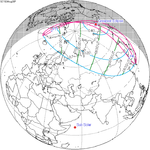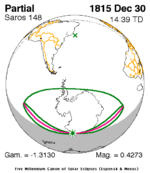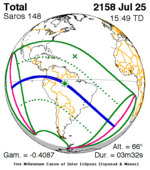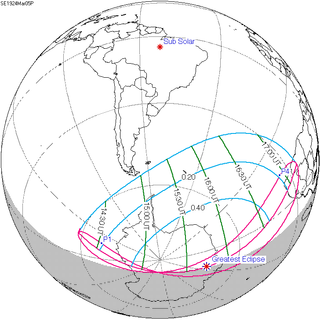Solar eclipse of March 5, 1924
| Solar eclipse of March 5, 1924 | |
|---|---|
| Type of eclipse | |
| Nature | Partial |
| Gamma | −1.2232 |
| Magnitude | 0.5819 |
| Maximum eclipse | |
| Coordinates | 71°54′S 55°36′E / 71.9°S 55.6°E |
| Times (UTC) | |
| Greatest eclipse | 15:44:20 |
| References | |
| Saros | 148 (16 of 75) |
| Catalog # (SE5000) | 9336 |
A partial solar eclipse occurred at the Moon's descending node of orbit on Wednesday, March 5, 1924, with a magnitude of 0.5819. A solar eclipse occurs when the Moon passes between Earth and the Sun, thereby totally or partly obscuring the image of the Sun for a viewer on Earth. A partial solar eclipse occurs in the polar regions of the Earth when the center of the Moon's shadow misses the Earth.
Related eclipses[edit]
Eclipses in 1924[edit]
- A total lunar eclipse on February 20, 1924.
- A partial solar eclipse on March 5, 1924.
- A partial solar eclipse on July 31, 1924.
- A total lunar eclipse on August 14, 1924.
- A partial solar eclipse on August 30, 1924.
Metonic[edit]
- Preceded by: Solar eclipse of May 18, 1920
- Followed by: Solar eclipse of December 24, 1927
Tzolkinex[edit]
- Preceded by: Solar eclipse of January 23, 1917
- Followed by: Solar eclipse of April 18, 1931
Half-Saros[edit]
- Preceded by: Lunar eclipse of March 1, 1915
- Followed by: Lunar eclipse of March 12, 1933
Tritos[edit]
- Preceded by: Solar eclipse of April 6, 1913
- Followed by: Solar eclipse of February 3, 1935
Solar Saros 148[edit]
- Preceded by: Solar eclipse of February 23, 1906
- Followed by: Solar eclipse of March 16, 1942
Inex[edit]
- Preceded by: Solar eclipse of March 26, 1895
- Followed by: Solar eclipse of February 14, 1953
Triad[edit]
- Preceded by: Solar eclipse of May 4, 1837
- Followed by: Solar eclipse of January 4, 2011
Solar eclipses of 1921–1924[edit]
This eclipse is a member of a semester series. An eclipse in a semester series of solar eclipses repeats approximately every 177 days and 4 hours (a semester) at alternating nodes of the Moon's orbit.[1]
The partial solar eclipse on July 31, 1924 occurs in the next lunar year eclipse set.
| Solar eclipse series sets from 1921 to 1924 | ||||||
|---|---|---|---|---|---|---|
| Descending node | Ascending node | |||||
| Saros | Map | Gamma | Saros | Map | Gamma | |
| 118 | April 8, 1921 Annular |
0.8869 | 123 | October 1, 1921 Total |
−0.9383 | |
| 128 | March 28, 1922 Annular |
0.1711 | 133 | September 21, 1922 Total |
−0.213 | |
| 138 | March 17, 1923 Annular |
−0.5438 | 143 | September 10, 1923 Total |
0.5149 | |
| 148 | March 5, 1924 Partial |
−1.2232 | 153 | August 30, 1924 Partial |
1.3123 | |
Saros 148[edit]
This eclipse is a part of Saros series 148, repeating every 18 years, 11 days, and containing 75 events. The series started with a partial solar eclipse on September 21, 1653. It contains annular eclipses on April 29, 2014 and May 9, 2032; a hybrid eclipse on May 20, 2050; and total eclipses from May 31, 2068 through August 3, 2771. The series ends at member 75 as a partial eclipse on December 12, 2987. Its eclipses are tabulated in three columns; every third eclipse in the same column is one exeligmos apart, so they all cast shadows over approximately the same parts of the Earth.
The longest duration of annularity will be produced by member 22 at 22 seconds (by default) on May 9, 2032, and the longest duration of totality will be produced by member 54 at 5 minutes, 23 seconds on April 26, 2609. All eclipses in this series occur at the Moon’s descending node of orbit.[2]
| Series members 10–31 occur between 1801 and 2200: | ||
|---|---|---|
| 10 | 11 | 12 |
 December 30, 1815 |
 January 9, 1834 |
 January 21, 1852 |
| 13 | 14 | 15 |
 January 31, 1870 |
 February 11, 1888 |
 February 23, 1906 |
| 16 | 17 | 18 |
 March 5, 1924 |
 March 16, 1942 |
 March 27, 1960 |
| 19 | 20 | 21 |
 April 7, 1978 |
 April 17, 1996 |
 April 29, 2014 |
| 22 | 23 | 24 |
 May 9, 2032 |
 May 20, 2050 |
 May 31, 2068 |
| 25 | 26 | 27 |
 June 11, 2086 |
 June 22, 2104 |
 July 4, 2122 |
| 28 | 29 | 30 |
 July 14, 2140 |
 July 25, 2158 |
 August 4, 2176 |
| 31 | ||
 August 16, 2194 | ||
References[edit]
- ^ van Gent, R.H. "Solar- and Lunar-Eclipse Predictions from Antiquity to the Present". A Catalogue of Eclipse Cycles. Utrecht University. Retrieved 6 October 2018.
- ^ "NASA - Catalog of Solar Eclipses of Saros 148". eclipse.gsfc.nasa.gov.
External links[edit]
- Earth visibility chart and eclipse statistics Eclipse Predictions by Fred Espenak, NASA/GSFC




